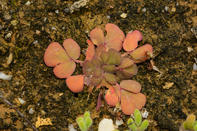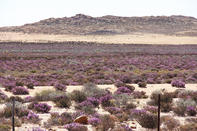Entrepreneurial Plants
The desert is home to scrubby vegetation that seldom reaches above knee-height and the summers stretch into endless, parched months. The austral winter brings a short respite of cold-weather rain. This is the gateway to Namaqualand's legendary wildflower displays.

Conditions have not changed much and the Knersvlakte remains as inhospitable now as it was for the trekboere three centuries ago. But deserts are only bad news to creatures that have not evolved there. They provide a niche for any plants or animals entrepreneurial enough to adapt and make this place home.
There is one such plant community that has carved out space for itself here on the Knersvlakte. In amongst the white quartzite stones lie a host of well-disguised, chubby little dwarf succulents.
The quartzite keeps the ground cool by reflecting sunlight and provides camouflage for these plants that have taken on the appearance of their surrounds. In summer, when the ground bakes and the rains retreat to the east, they shrivel back into the ground under a cover of gravel and their own dead skin.
Winter’s Rain

The succulents stay dormant, until winter's rains bounce them back into their full, voluptuous curves. In celebration, they throw out showers of colourful petals. To these natives, the Knersvlakte is paradise. After thousands of years, desert conditions have tailored this species to retain water in the same way that a camel's hump stores fat for the lean months.
The succulents are efficient little operators - they siesta all summer long, like bears hibernating through winter. By shutting down their metabolism and coating their green-grey reflective leaves in a waxy sunscreen, they endure the searing desert summer.
Their roots skim water from just below the surface of the ground, whether from dew or mist. When the rains do come, the succulents burst into a flurry of growth. But just when they start blooming, the winter sun angles itself lower in the sky, sending in gentle rays at an acute angle.
The plants compensated for this by evolving bulbous, cushion-shaped leaves that hug the ground and absorb the solar energy like sponges. Their woody seed pods open welcomingly with the first sprinkles of rain, allowing their seeds to be shot hither and thither by the impact of the shower - a clever device to ensure their seeds are only released when conditions are favourable for germination.
Hidden as they are from the world - as much by their own camouflage as by the climate that keeps intruders away - not many people know that the Knersvlakte harbours among the richest succulent communities in the world. At least 150 species are endemic to the area.
The wider succulent karoo of the West Coast is itself a masterpiece of nature, containing the largest concentration of succulents in the world, more than half of which are endemic. South Africa (both the summer and winter rainfall areas) has about 3 500 species of succulents, roughly 80 percent of which, are endemic to South Africa. The majority of these are crammed into this island of arid, winter rainfall.
Like the rich diversity of fynbos that grows just south of here, the succulent karoo has been identified as a 'biodiversity hotspot' - rich in diversity but most threatened by, among other things, climate change.
By Leonie Joubert